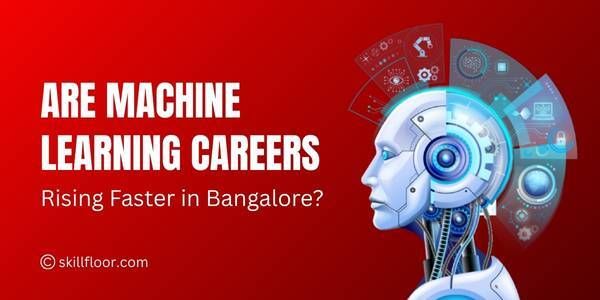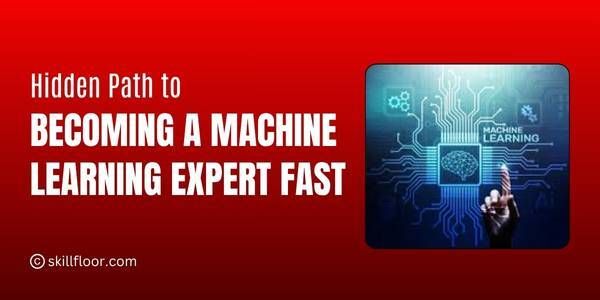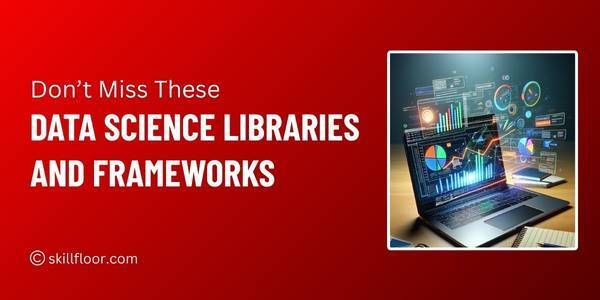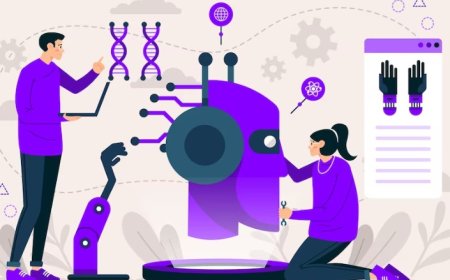A Guide to a Complete Machine Learning Syllabus
Explore a comprehensive machine learning syllabus for 2025 covering fundamentals, algorithms, deep learning, deployment, and practical projects to master ML.

Hey there! If you’re curious about machine learning or thinking about diving into this exciting field, you’re in the right place. Machine learning isn’t just some fancy tech buzzword; it’s a powerful tool that’s changing how we interact with technology every day. From Netflix recommendations and voice assistants to self-driving cars and medical diagnoses, machine learning is behind it all. But getting started can feel overwhelming. There’s a lot to learn, from math and programming to algorithms and real-world applications. That’s why having a clear, step-by-step syllabus is super helpful. It guides you through what to learn, when to learn it, and how everything connects.
Machine learning (ML) has emerged as one of the most transformative technologies of the 21st century. From powering recommendation systems and self-driving cars to revolutionizing healthcare and finance, ML algorithms are reshaping industries globally. As organizations increasingly adopt AI-driven solutions, the demand for skilled professionals with strong machine learning expertise continues to soar. To meet this demand, a well-structured syllabus is crucial for learners to systematically grasp both the foundational concepts and advanced techniques.
A comprehensive machine learning syllabus not only covers the theoretical underpinnings but also emphasizes practical implementation and real-world problem solving. It introduces learners to algorithms, statistical methods, programming skills, data processing, and model evaluation. Given the interdisciplinary nature of ML, the syllabus integrates knowledge from mathematics, computer science, and domain-specific applications.
Whether you’re a student, professional, or self-learner, this guide will provide clarity on what to study and how to progress in this exciting field, backed by expert insights and industry standards.
1. Foundations of Machine Learning
The foundations of machine learning (ML) form the critical base upon which all advanced techniques and applications are built. This section introduces learners to the fundamental concepts, mathematics, and tools essential to understanding and implementing machine learning algorithms effectively.
Introduction to Machine Learning
Machine learning is a subset of artificial intelligence where computers learn from data and improve their performance without explicit programming. Understanding its scope and history gives context to how ML evolved from rule-based AI systems to data-driven algorithms capable of complex decision-making. Learners explore key applications such as speech recognition, recommendation systems, and image processing, which demonstrate the transformative power of ML in various industries.
A clear distinction is made between artificial intelligence (AI), machine learning (ML), and deep learning (DL). AI is the broadest field focused on creating intelligent systems. ML is a subset of AI focused on algorithms that learn from data, while DL is a further subset that uses deep neural networks to model high-level abstractions in data.
Types of Machine Learning
Four primary types of ML are covered:
-
Supervised learning, where models learn from labeled data to make predictions.
-
Unsupervised learning which finds hidden patterns in unlabeled data.
-
Semi-supervised learning combines small amounts of labeled data with large unlabeled datasets.
-
Reinforcement learning, where agents learn by interacting with an environment and receiving feedback in the form of rewards or penalties.
Each type has unique algorithms and use cases, helping learners identify which method fits their problem domain.
Prerequisites for Machine Learning
ML is math-intensive. Key areas include:
-
Linear Algebra: The language of data in ML. Vectors, matrices, and operations on them are used to represent data, weights, and transformations in algorithms.
-
Probability and Statistics: Crucial for understanding data distributions, modeling uncertainty, and making predictions. Concepts like conditional probability, Bayes' theorem, and statistical tests are foundational.
-
Calculus: Differentiation and integration underpin optimization algorithms such as gradient descent, which is used to minimize errors in models.
-
Programming: Python is the most popular language for ML due to its simplicity and powerful libraries. Learners must grasp the basics of Python programming, data structures, and algorithms to manipulate data and implement models.
Tools and Environments
Practical ML requires the right tools. Python libraries such as NumPy enable efficient numerical operations; pandas helps in data manipulation; matplotlib and seaborn facilitate data visualization; scikit-learn offers pre-built ML algorithms for beginners.
Interactive environments like Jupyter notebooks provide an excellent platform to write and test code, visualize data, and document findings. Version control with Git helps manage code changes collaboratively. Additionally, cloud platforms like AWS, Google Cloud, and Azure provide scalable computing power and ready-to-use ML services for deploying models.
Why This Foundation Matters
This foundational knowledge is essential to build confidence and competence in ML. Without a solid grasp of math, programming, and basic ML concepts, it’s difficult to understand how algorithms work or how to troubleshoot models. Mastery here sets the stage for tackling more complex topics such as deep learning, reinforcement learning, and deployment.
2. Data Preparation and Processing
Data preparation and processing is a crucial phase in the machine learning pipeline. Since ML models learn from data, the quality and structure of that data directly impact the accuracy and performance of the models. Often, real-world data is messy, inconsistent, and incomplete, making it imperative to clean, transform, and engineer features effectively before feeding it into algorithms.
Data Collection and Exploration
The first step in any ML project is gathering data. Data can come from various sources — structured data stored in databases, unstructured data like text, images, and videos, or semi-structured data such as JSON or XML files. Data might be collected through APIs, web scraping, IoT sensors, or public datasets.
Once data is collected, exploratory data analysis (EDA) helps to understand its structure, distribution, and relationships. Visualization tools such as histograms, scatter plots, and box plots reveal important insights like skewness, correlations, and outliers. EDA aids in identifying the quality of data and informs subsequent cleaning and feature engineering steps.
Data Cleaning and Transformation
Raw data usually contains errors: missing values, duplicates, inconsistent formats, and outliers. Handling these issues is vital for building robust ML models:
-
Handling missing data: Techniques include deletion (if missingness is small) or imputation (filling missing values with mean, median, mode, or predictive models).
-
Normalizing and standardizing: Features with different scales can bias models. Normalization (scaling data between 0 and 1) or standardization (transforming data to have zero mean and unit variance) ensures uniformity.
-
Encoding categorical variables: Machine Learning algorithms typically require numerical input, so categorical variables need to be converted using methods like one-hot encoding, label encoding, or target encoding.
-
Outlier detection and treatment: Outliers can distort model training. Statistical methods or visualization help identify outliers, which can then be capped, removed, or transformed.
Feature Engineering
Feature engineering transforms raw data into meaningful input features that improve model accuracy. This is often considered both an art and a science in ML:
-
Feature selection: Identifying the most relevant variables to reduce noise and computational complexity. Techniques include correlation analysis, recursive feature elimination, and tree-based feature importance.
-
Feature extraction: Creating new features from existing data to better represent underlying patterns. Dimensionality reduction techniques like Principal Component Analysis (PCA) and Linear Discriminant Analysis (LDA) reduce feature space while retaining information.
-
Creating derived features: Combining or transforming raw variables based on domain knowledge. For example, extracting “day of the week” from a date or creating interaction terms between variables.
Importance of Data Preparation
The quality of data preparation is often the biggest determinant of model success. Studies suggest that up to 80% of an ML project’s time is spent on data cleaning and feature engineering. Poorly prepared data leads to misleading results, overfitting, or underperforming models, whereas meticulous preparation helps algorithms learn meaningful patterns and generalize well.
Tools and Techniques
Several Python libraries facilitate data preparation:
-
Pandas for data manipulation and cleaning,
-
scikit-learn’s preprocessing module for scaling and encoding,
-
matplotlib/seaborn for visualization,
-
Feature-engine for automated feature engineering tasks.

Data preparation is not just a technical requirement but a strategic step in ML workflows. A thorough understanding of the data’s nature, thoughtful cleaning, and creative feature engineering directly impact the effectiveness of the learning process and final model performance. Mastery of these skills empowers you to turn raw data into actionable insights and build robust ML solutions.
3. Supervised Learning Algorithms
Supervised learning is one of the most widely used types of machine learning. In this approach, algorithms learn from labeled datasets, where the input data is paired with the correct output. The goal is to train a model that can predict the output for new, unseen inputs accurately. This section covers fundamental supervised learning algorithms and their applications, evaluation metrics, and advanced techniques.
Regression
Regression algorithms predict continuous numerical values based on input features. They are widely used in scenarios such as predicting house prices, sales forecasting, or stock market trends.
-
Simple Linear Regression: It models the relationship between one independent variable and a continuous dependent variable by fitting a straight line.
-
Multiple Linear Regression: Extends simple linear regression to multiple input variables, capturing more complex relationships.
-
Polynomial Regression: Useful for modeling nonlinear relationships by introducing polynomial terms.
Key evaluation metrics for regression include:
-
Mean Squared Error (MSE): Average squared difference between predicted and actual values, sensitive to outliers.
-
Root Mean Squared Error (RMSE): Square root of MSE, interpretable in the same units as the target variable.
-
Mean Absolute Error (MAE): Average absolute difference between predictions and actuals, more robust to outliers.
-
R-squared (R²): Proportion of variance in the dependent variable explained by the model.
Classification
Classification predicts discrete categories or classes, such as spam detection, disease diagnosis, or sentiment analysis.
-
Logistic Regression: Despite its name, it is a classification algorithm used for binary outcomes. It models the probability of a class using the logistic function.
-
k-Nearest Neighbors (k-NN): Classifies a point based on the majority label among its nearest neighbors. Simple yet effective for many tasks.
-
Support Vector Machines (SVM): Find the hyperplane that best separates classes in high-dimensional space. Effective for linear and non-linear data using kernel tricks.
-
Decision Trees: Create a tree-like model of decisions by splitting data based on feature values. Intuitive and easy to visualize.
-
Random Forests: An Ensemble of decision trees that improves accuracy by averaging multiple trees to reduce overfitting.
-
Naive Bayes: Based on Bayes’ theorem, assumes feature independence. Fast and effective, especially in text classification.
Evaluation metrics for classification include
-
Accuracy: Percentage of correct predictions.
-
Precision: How many predicted positives are positive?
-
Recall: How many actual positives were correctly identified?
-
F1 Score: Harmonic mean of precision and recall, useful when classes are imbalanced.
-
ROC Curve and AUC: Trade-off between true positive rate and false positive rate.
Advanced Supervised Models
Beyond basic algorithms, advanced models like gradient boosting machines have gained popularity due to their high predictive power.
-
Gradient Boosting Machines (GBM): Build models sequentially to correct errors of previous ones, reducing bias and variance.
-
XGBoost and LightGBM: Efficient implementations of GBM optimized for speed and performance. Widely used in competitions and industry.
-
Ensemble Methods: Combine predictions from multiple models to improve robustness and accuracy. Bagging and boosting are popular ensemble strategies.
Model Tuning and Hyperparameter Optimization
Tuning model parameters (e.g., learning rate, tree depth, regularization strength) is crucial for optimal performance. Techniques include:
-
Grid Search: Exhaustive search over specified parameter values.
-
Random Search: Randomly samples parameters for efficiency.
-
Bayesian Optimization: Uses probabilistic models to find the best parameters efficiently.
Supervised learning forms the backbone of many practical machine learning applications, offering tools to predict continuous values or classify categories with high accuracy. Understanding the strengths, weaknesses, and appropriate evaluation metrics for each algorithm helps you select and tune models effectively. Mastery of supervised algorithms is essential before moving into more complex areas like unsupervised and reinforcement learning.
4. Unsupervised Learning Algorithms
Unsupervised learning is a branch of machine learning where models work with data that has no labeled responses. Instead of predicting an outcome, these algorithms find hidden patterns, groupings, or structures within the data. This section explores the most important unsupervised learning techniques, their applications, and how to evaluate their effectiveness.
Clustering
Clustering is one of the core unsupervised learning tasks. It groups similar data points into clusters based on their features, without prior knowledge of group labels. Clustering is widely used for customer segmentation, image compression, anomaly detection, and more.
-
k-Means Clustering: One of the simplest and most popular clustering algorithms. It partitions data into k clusters by iteratively assigning points to the nearest cluster centroid and recalculating centroids until convergence. It works best on spherical clusters with similar sizes, but can struggle with irregular cluster shapes or noisy data.
-
Hierarchical Clustering: Builds a tree of clusters either by starting with individual points and merging them (agglomerative) or by starting with one cluster and splitting it (divisive). It provides a dendrogram showing cluster relationships, which is useful for understanding data at multiple levels.
-
DBSCAN (Density-Based Spatial Clustering of Applications with Noise): Clusters points that are densely packed together, identifying outliers as noise. It can find arbitrarily shaped clusters and is robust to noise, making it ideal for complex spatial data.
Cluster validation is important to assess how well the clustering represents the underlying data structure. Metrics like the silhouette score, Davies-Bouldin index, and Calinski-Harabasz index help quantify cluster quality.
Dimensionality Reduction
High-dimensional data can be difficult to visualize and process. Dimensionality reduction techniques transform data into fewer dimensions while preserving essential information, which improves computational efficiency and reduces noise.
-
Principal Component Analysis (PCA): A linear technique that transforms data into a set of orthogonal components (principal components) ordered by the amount of variance they explain. PCA helps visualize high-dimensional data and often serves as a preprocessing step before other ML tasks.
-
t-Distributed Stochastic Neighbor Embedding (t-SNE): A nonlinear method that projects data into 2 or 3 dimensions, preserving local structure and relationships. t-SNE is highly effective for visualizing clusters and complex patterns but is computationally intensive and mainly used for visualization rather than feature extraction.
-
Autoencoders: Neural networks trained to reconstruct input data through a compressed latent space. They learn nonlinear transformations and are useful for dimensionality reduction, anomaly detection, and generative modeling.
Anomaly Detection
Anomaly detection aims to identify rare or unusual data points that deviate significantly from the majority. This is critical in applications such as fraud detection, network security, and fault diagnosis.
Common techniques include:
-
Statistical methods: Based on the assumption that normal data points follow a distribution; points far from this distribution are anomalies.
-
Distance-based methods: Use distance metrics to identify points far from clusters.
-
Isolation Forests: An ensemble method that isolates anomalies by randomly partitioning data; anomalies require fewer partitions.
-
Autoencoder-based methods: Use reconstruction error to detect anomalies.
Importance of Unsupervised Learning
Unsupervised learning is powerful when labeled data is scarce or unavailable. It helps discover natural groupings and underlying structure, which can inform business decisions, improve supervised models by feature learning, and detect outliers before model training.
Unsupervised learning complements supervised learning by revealing hidden patterns without labeled data. Clustering, dimensionality reduction, and anomaly detection each serve unique roles in analyzing complex datasets. Mastering these techniques enhances your ability to work with diverse real-world problems where labels are often unavailable or incomplete.
5. Reinforcement Learning
Reinforcement Learning (RL) is a distinctive branch of machine learning focused on training agents to make decisions by interacting with an environment. Unlike supervised or unsupervised learning, RL is about learning from the consequences of actions to maximize long-term rewards. This section explains core concepts, key algorithms, and practical applications of reinforcement learning.
Basics of Reinforcement Learning
In RL, an agent learns to perform actions within an environment to achieve a goal. The process is often modeled as a Markov Decision Process (MDP), characterized by states, actions, rewards, and state transitions.
-
States: Represent the current situation or context of the environment.
-
Actions: Choices available to the agent at any state.
-
Rewards: Feedback signals the agent receives after taking an action, guiding learning.
-
Policy: A strategy that maps states to actions. The goal is to learn an optimal policy that maximizes cumulative rewards over time.
A fundamental challenge in RL is balancing exploration (trying new actions to discover better rewards) and exploitation (choosing known actions that yield high rewards).
Key Algorithms in Reinforcement Learning
Several algorithms have been developed to tackle the decision-making problem in RL:
-
Q-Learning: A model-free, value-based algorithm where the agent learns a Q-value function that estimates the expected reward of taking an action in a given state. The policy is derived by selecting the action with the highest Q-value.
-
Deep Q Networks (DQN): Combines Q-Learning with deep neural networks to handle large state spaces like images or game frames. DQN has been pivotal in breakthroughs like mastering Atari games.
-
Policy Gradient Methods: Unlike value-based methods, policy gradient algorithms learn the policy directly by optimizing the expected reward. Techniques like REINFORCE and Actor-Critic models fall under this category, allowing more complex and continuous action spaces.
Applications of Reinforcement Learning
Reinforcement learning shines in problems where decision making involves sequential actions and delayed rewards, including:
-
Robotics: Teaching robots to perform complex tasks such as walking, grasping objects, or navigating.
-
Game AI: RL agents have famously mastered games like Chess, Go, and complex video games, often surpassing human performance.
-
Autonomous Vehicles: RL helps self-driving cars make real-time decisions on steering, acceleration, and obstacle avoidance.
-
Finance: Portfolio management and automated trading strategies use RL to adapt to changing markets.
Challenges and Considerations
RL systems require careful design due to their complexity:
-
Sample Efficiency: RL often needs large amounts of interaction data to learn effectively, which can be costly or time-consuming in real-world applications.
-
Reward Design: Crafting a reward function that truly reflects the desired behavior is critical but challenging. Poorly designed rewards can lead to unintended consequences.
-
Safety and Ethics: In real-world applications like autonomous driving, ensuring safe exploration and adherence to ethical standards is paramount.
Reinforcement learning empowers machines to learn optimal behaviors through trial and error, mimicking how humans and animals learn from experience. Its unique approach to sequential decision-making unlocks possibilities across robotics, gaming, autonomous systems, and beyond. Understanding core concepts, algorithms, and challenges equips practitioners to harness RL’s power responsibly and effectively.
6. Deep Learning and Neural Networks
Deep learning is a specialized subfield of machine learning focused on artificial neural networks with many layers. It has revolutionized fields such as computer vision, natural language processing, and speech recognition by enabling models to automatically learn hierarchical representations from raw data. This section dives into the basics of neural networks, popular deep learning architectures, and advanced techniques.
Introduction to Neural Networks
Artificial neural networks (ANNs) are computational models inspired by the human brain’s neural structure. They consist of layers of interconnected nodes, or “neurons,” which process data by passing signals and applying activation functions.
-
Neurons and Layers: Each neuron receives inputs, applies weights, sums them, adds a bias, and passes the result through an activation function to produce output. Networks usually have an input layer, multiple hidden layers, and an output layer.
-
Activation Functions: Introduce non-linearity into the model, enabling it to learn complex patterns. Common functions include ReLU (Rectified Linear Unit), sigmoid, and tanh.
-
Forward and Backward Propagation: Forward propagation calculates outputs given inputs. Backpropagation computes gradients of the loss function with respect to weights, enabling training via optimization algorithms like gradient descent.
Deep Learning Models
Several deep learning architectures address different types of data and tasks:
-
Feedforward Neural Networks (FNNs): The simplest form of ANN, where information moves in one direction from input to output. Used for general prediction tasks.
-
Convolutional Neural Networks (CNNs): Designed for image and spatial data, CNNs use convolutional layers to automatically detect features like edges, textures, and shapes. They are the backbone of modern computer vision systems.
-
Recurrent Neural Networks (RNNs): Specialized for sequential data such as time series, text, or speech. RNNs use loops to maintain memory of previous inputs. Variants like Long Short-Term Memory (LSTM) and Gated Recurrent Units (GRU) address the issue of learning long-range dependencies.
Advanced Topics in Deep Learning
-
Transfer Learning: Reusing pretrained models on large datasets to solve related tasks with less data, significantly speeding up training and improving performance.
-
Generative Adversarial Networks (GANs): Consist of two networks — a generator and a discriminator — competing against each other to produce realistic synthetic data, widely used for image synthesis and data augmentation.
-
Attention Mechanisms and Transformers: These mechanisms allow models to focus on important parts of input data dynamically. Transformers have revolutionized natural language processing by enabling highly parallelizable and effective sequence modeling, powering models like BERT and GPT.
Why Deep Learning Matters
Deep learning’s ability to automatically extract features and model complex relationships makes it indispensable for tasks previously impossible or impractical. With growing computational power and large datasets, deep learning continues to push the boundaries of AI capabilities.
Neural networks form the foundation of deep learning, allowing machines to learn rich representations from raw data. From basic feedforward architectures to sophisticated CNNs and transformers, deep learning models dominate many cutting-edge AI applications. Understanding these concepts and techniques prepares practitioners to tackle real-world problems involving images, speech, and natural language with state-of-the-art tools.
7. Model Evaluation and Validation
Evaluating and validating machine learning models is a crucial step to ensure that models perform well not only on training data but also on unseen data. Without proper evaluation, models might overfit the training data—capturing noise instead of patterns—or underfit, failing to capture important relationships. This section covers key concepts, techniques, and metrics for robust model evaluation.
Training and Testing Data
To measure a model’s ability to generalize, datasets are typically divided into:
-
Training set: Used to train the model.
-
Testing set: Held back during training and used to assess model performance on unseen data.
Splitting data ensures that evaluation mimics real-world performance. A common split is 70-80% training and 20-30% testing. However, using a single train-test split can lead to biased results if the split is not representative.
Cross-validation addresses this by dividing data into multiple folds, training on some folds and testing on others iteratively.
-
K-fold cross-validation is widely used: the data is split into k equal parts, and the model is trained and tested k times, each time leaving out one fold for testing.
-
Stratified k-fold ensures each fold has a representative distribution of classes, crucial for imbalanced datasets.
Evaluation Metrics
The choice of evaluation metrics depends on the type of ML task:
-
Classification Metrics:
-
Accuracy: Proportion of correct predictions. Good for balanced datasets.
-
Precision: Of all predicted positives, how many are actually positive? Important when false positives are costly.
-
Recall (Sensitivity): Of all actual positives, how many were correctly predicted? Critical when missing positives is costly.
-
F1 Score: Harmonic mean of precision and recall; balances both for imbalanced data.
-
ROC Curve and AUC: Plot of true positive rate vs. false positive rate; AUC quantifies the overall ability to discriminate between classes.
-
Regression Metrics:
-
Mean Squared Error (MSE): Average squared difference between predicted and actual values; penalizes larger errors more.
-
Root Mean Squared Error (RMSE): Square root of MSE, in the same unit as the target.
-
Mean Absolute Error (MAE): Average absolute difference; less sensitive to outliers.
-
R-squared (R²): Proportion of variance explained by the model.
Avoiding Overfitting and Underfitting
-
Overfitting occurs when a model learns the noise and details of the training data, performing poorly on new data.
-
Underfitting happens when the model is too simple to capture underlying patterns.
Balancing these requires understanding the bias-variance tradeoff:
-
High bias leads to underfitting, and high variance leads to overfitting. The goal is to find the optimal point.
Techniques to prevent overfitting include:
-
Regularization: Adding penalties (L1, L2) to the loss function to discourage overly complex models.
-
Dropout: Randomly “dropping” neurons during training in neural networks to prevent co-dependency.
-
Early stopping: Halting training when performance on validation data starts to degrade.
-
Simplifying the model: Using fewer features or simpler algorithms.
Model Selection and Hyperparameter Tuning
Choosing the right model and tuning its parameters significantly impact performance. Techniques include:
-
Grid search: Exhaustive search over a predefined set of hyperparameters.
-
Random search: Randomly samples hyperparameters, more efficient in large search spaces.
-
Bayesian optimization: Uses probabilistic models to efficiently explore hyperparameters.
Model evaluation and validation ensure that machine learning models generalize well to unseen data, providing reliable predictions in real-world scenarios. Employing proper train-test splits, cross-validation, appropriate metrics, and techniques to avoid overfitting are fundamental best practices. These steps make your models trustworthy and ready for deployment.
8. Machine Learning Deployment and Monitoring
Building a machine learning model is only half the battle. To truly deliver value, models need to be deployed into production environments where they can generate real-time or batch predictions. Equally important is monitoring these deployed models to ensure they maintain performance over time. This section covers deployment strategies, ongoing monitoring, and ethical considerations.
Model Deployment Strategies
Model deployment transforms a trained machine learning model into a usable service or product. Common deployment approaches include:
-
Batch inference: Models generate predictions on large datasets at scheduled intervals. Suitable for scenarios where real-time predictions are not critical, such as monthly sales forecasting.
-
Real-time inference: Models serve predictions instantly in response to user inputs, powering applications like chatbots, fraud detection, or recommendation engines.
Popular deployment tools and frameworks include:
-
APIs: Using frameworks like Flask or FastAPI to create web services that expose the model to other applications.
-
Containerization: Packaging models and dependencies into Docker containers ensures consistency across different environments.
-
Cloud services: Platforms like AWS SageMaker, Google AI Platform, and Azure ML offer end-to-end deployment pipelines, scalability, and integration with other services.
Monitoring and Maintenance
Deployed models face changing environments and data, which can degrade their performance, a phenomenon called model drift. Continuous monitoring is essential:
-
Performance tracking: Monitor prediction accuracy, response time, and other business KPIs using dashboards and alerts.
-
Data drift detection: Identify when input data distributions shift significantly from the training data, which can impact model predictions.
-
Model retraining: Schedule retraining on fresh data or use automated pipelines to adapt models to evolving patterns.
-
Logging and auditing: Maintain logs for predictions and decisions to support debugging, compliance, and explainability.
Ethics and Responsible AI
With increasing reliance on ML models, ethical considerations are paramount:
-
Fairness: Avoid biased models that discriminate against particular groups. Implement bias detection and mitigation techniques.
-
Transparency: Use explainable AI techniques to make models’ decisions interpretable to stakeholders and users.
-
Privacy: Ensure compliance with data protection laws such as GDPR by anonymizing data and securing sensitive information.
-
Accountability: Establish responsibility for model outcomes, especially in critical domains like healthcare or finance.
Tools and Best Practices
-
Use MLflow, TensorFlow Serving, or Kubeflow for managing deployment and monitoring workflows.
-
Automate deployment with CI/CD pipelines integrated with version control.
-
Maintain clear documentation for all stages of deployment and monitoring to ensure reproducibility and compliance.
Deployment and monitoring are critical phases that turn machine learning models into actionable solutions. Effective deployment ensures models are accessible and scalable, while diligent monitoring safeguards ongoing accuracy and fairness. Combining technical rigor with ethical responsibility leads to sustainable AI systems that deliver real business value.
9. Practical Projects and Case Studies
Practical projects and case studies are vital components of a comprehensive machine learning syllabus. They provide hands-on experience and contextual understanding, bridging the gap between theoretical concepts and real-world applications. This section emphasizes the importance of experiential learning and highlights typical projects and case studies that reinforce key machine learning skills.
Real-World Projects
Working on practical projects allows learners to apply algorithms to actual datasets, enhancing their problem-solving abilities. Examples of commonly recommended projects include:
-
Predictive Analytics: Using historical data to forecast future trends. For instance, sales prediction for retail businesses or demand forecasting in supply chains. This project teaches regression models, feature engineering, and evaluation metrics.
-
Customer Segmentation: Grouping customers based on purchasing behavior or demographics using clustering algorithms like k-Means or hierarchical clustering. This helps learners understand unsupervised learning and its business value.
-
Sentiment Analysis: Analyzing text data (e.g., social media reviews) to determine positive or negative sentiment. This project introduces natural language processing (NLP) techniques, text preprocessing, and classification models.
-
Image Classification: Classifying images using Convolutional Neural Networks (CNNs). This project provides hands-on experience with deep learning and computer vision.
-
Anomaly Detection: Detecting fraudulent transactions or network intrusions by identifying outliers in data. This teaches techniques like isolation forests and autoencoders.
By completing such projects, learners gain insights into data preprocessing, model selection, tuning, and deployment challenges.
Industry Case Studies
Studying real-life industry implementations helps learners appreciate the practical impact of machine learning across sectors:
-
Healthcare: Machine learning aids in medical diagnostics, predicting disease progression, and personalized treatment plans. Case studies highlight how ML models analyze patient data to assist doctors.
-
Finance: Fraud detection systems use anomaly detection and classification to identify suspicious transactions, helping prevent financial losses.
-
Autonomous Vehicles: Reinforcement learning and computer vision models enable self-driving cars to navigate complex environments safely.
-
Natural Language Processing (NLP): Voice assistants and chatbots rely on advanced ML models to understand and respond to human language.
Industry case studies often address challenges like data privacy, interpretability, and real-time decision-making, providing learners with a holistic view of applying ML responsibly.
Benefits of Practical Learning
-
Skill Reinforcement: Applying theory solidifies understanding and uncovers gaps.
-
Portfolio Development: Real projects showcase abilities to potential employers.
-
Problem-Solving: Learners develop critical thinking by dealing with noisy, incomplete, or imbalanced data.
-
Collaboration: Group projects foster teamwork and communication skills, essential in professional settings.
Tips for Successful Projects
-
Start with clear problem definitions and goals.
-
Explore and clean the data thoroughly before modeling.
-
Use visualization to gain insights and guide feature engineering.
-
Experiment with multiple algorithms and compare results.
-
Document your process and results comprehensively.
-
Seek feedback and iterate for improvement.
Incorporating practical projects and industry case studies is indispensable for mastering machine learning. They translate theoretical knowledge into actionable skills and prepare learners for real-world challenges. Engaging with hands-on tasks and exploring sector-specific applications nurtures well-rounded, job-ready professionals capable of driving innovation through machine learning.
10. Resources for Learning and Certification
Navigating the vast field of machine learning requires access to quality learning resources and credible certification programs. This section highlights the best educational platforms, books, research materials, and communities that support continuous learning, skill development, and professional recognition.
Online Courses and Tutorials
Online platforms have revolutionized access to machine learning education, offering courses from top universities and industry experts. Popular platforms include:
-
Coursera: Courses like Andrew Ng’s “Machine Learning” and the “Deep Learning Specialization” provide comprehensive coverage from basics to advanced topics, often accompanied by practical assignments.
-
edX: Offers courses from institutions like MIT and Harvard, including professional certificate programs in data science and AI.
-
Udacity: Known for its “Nanodegree” programs, Udacity focuses on hands-on projects and career-oriented learning paths.
-
Fast.ai: Provides free, practical deep learning courses with a focus on coding and rapid prototyping.
-
Kaggle: Beyond competitions, Kaggle offers free micro-courses covering Python, machine learning, and data visualization, combined with real datasets for practice.
Books and Research Papers
Books offer in-depth theoretical understanding and detailed explanations:
-
“Pattern Recognition and Machine Learning” by Christopher M. Bishop: A foundational text for ML theory and algorithms.
-
“Deep Learning” by Ian Goodfellow, Yoshua Bengio, and Aaron Courville: The go-to resource for understanding neural networks and deep learning.
-
“Hands-On Machine Learning with Scikit-Learn, Keras, and TensorFlow” by Aurélien Géron: A Practical guide combining theory with coding examples.
-
Regularly reading research papers from sources like arXiv and Google Scholar keeps learners updated with state-of-the-art advancements and novel techniques.
Community and Forums
Active participation in communities accelerates learning through collaboration and problem-solving:
-
Stack Overflow: A hub for technical questions and coding solutions.
-
Reddit’s r/MachineLearning: A discussion forum for research, tutorials, and news.
-
GitHub: Explore open-source projects, share code, and collaborate with other developers.
-
Kaggle Forums: Connect with data scientists, participate in discussions, and share insights from competitions.
Certification Programs
Certifications validate your skills to employers and demonstrate commitment to the field. Some reputable certifications include:
-
Google Professional Machine Learning Engineer: Focuses on designing and implementing ML models in production.
-
AWS Certified Machine Learning – Specialty: Covers building, training, and deploying ML models on AWS.
-
Microsoft Certified: Azure AI Engineer Associate: Validates expertise in Azure AI solutions.
-
Certified TensorFlow Developer: Focuses on building models using TensorFlow.
-
IBM Machine Learning Professional Certificate: Comprehensive program covering algorithms, tools, and deployment.
Tips for Choosing Resources and Certifications
-
Match learning resources to your current skill level and goals.
-
Prioritize hands-on courses with projects for practical experience.
-
Regularly update your knowledge with the latest research and tools.
-
Choose certifications recognized in your industry or by employers you aim to work with.
-
Engage actively in communities to reinforce learning and network professionally.
A well-rounded machine learning education blends structured courses, authoritative books, active community involvement, and recognized certifications. Leveraging these resources ensures continuous skill development and professional credibility. Staying curious and connected with the ML community is key to mastering this fast-evolving field.
Machine learning continues to be a dynamic and fast-growing field, transforming industries and opening up myriad career opportunities. A well-designed machine learning syllabus is fundamental for anyone aspiring to build expertise, providing a roadmap that balances theory, practical skills, and ethical considerations. This comprehensive syllabus covers everything from foundational mathematics and programming to advanced neural networks and deployment strategies, ensuring learners develop a robust and holistic understanding.
By following such a structured syllabus, learners can progressively build the essential skills needed to design, implement, and maintain effective machine learning models. The inclusion of real-world projects and case studies bridges the gap between theoretical knowledge and practical application, a crucial factor for professional success. Furthermore, awareness of responsible AI principles and ethical considerations is increasingly important as ML systems become integral to daily life.
Whether you are a student, working professional, or self-learner, this syllabus offers a pathway to becoming a competent machine learning practitioner. Continuous learning, hands-on experimentation, and staying updated with industry advancements are key to thriving in this evolving discipline. Equip yourself with this knowledge to contribute meaningfully to the future of technology and innovation.






























































